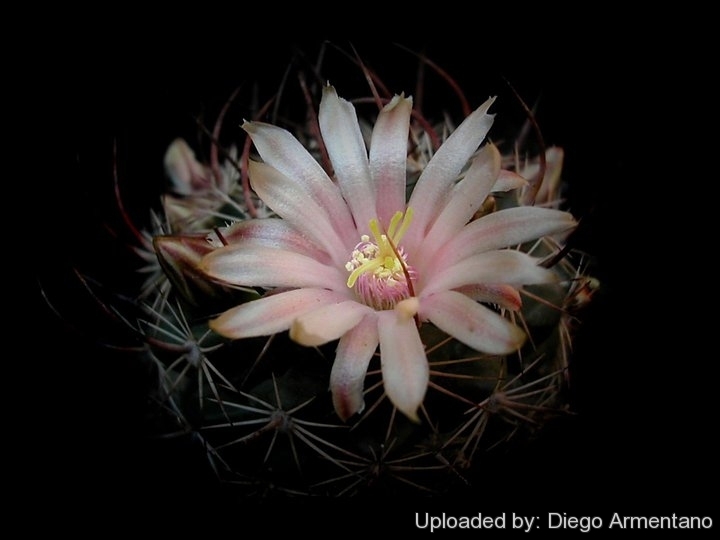Accepted Scientific Name: Mammillaria johnstonii (Britton & Rose) Orcutt
Cactography 7 1926. Orcutt

Neomammillaria johnstonii (Mammillaria johnstonii) Photo by: Diego Armentano
Origin and Habitat: Mammillaria johnstoniiSN|8817]]SN|32831]] is endemic to Mexico, and is found in the San Carlos Bay, State of Sonora, Mexico, mainly in the vicinity of Guaymas. It has a small range size (extent of occurrence is 1,000 km2), and only two locations. It is a locally common species.
Altitude range: From sea level up to 100 metres above sea level.
Habitat and Ecology: Near coast, Lower Sonoran Zone. This species occurs in steep, rocky hills in the Sonoran desert scrub, and is also found in aluvial soil together with Mammillaria inaiaeSN|3779]]SN|8824]], Mammillaria booliiSN|8824]]SN|3779]], Mammillaria swingleiSN|32831]]SN|8817]], Marshallocereus thurberiSN|8268]]SN|8268]], Pachycereus pringleiSN|8572]]SN|8572]], Echinocereus scopulorumSN|21773]], Echinocereus scopulorumSN|21773]] and Ferocactus emoryiSN|21495]]SN|21495]]. Generation Length (years) 10. The species' range is impacted by urban development, including tourism facilities, and aquaculture (shrimp farming). It is cultivated, but there is no significant collection from wild population.
Synonyms:
See all synonyms of Mammillaria johnstonii
back
Accepted name in llifle Database:Mammillaria johnstonii (Britton & Rose) OrcuttCactography 7 1926.Synonymy: 5
back
Common Names include:
ENGLISH: Cream Pincushion
Description: Mammillaria johnstoniiSN|32831]]SN|32831]] is large for the genus, usually solitary but occasionally clustering basally, eventually 15 to 20 cm high. Flowers white to pale pink to cream, with pink to brownish midveins, to 20 mm in diameter.
Stem: Globular to short-oblong, dull bluish gray-green, 15 to 20 cm high and 10 cm in diameter, slightly depressed at apex.
Tubercles: 1 to 1.5 cm long, 6-9 mm broad at base, 4-angled throughout, in 13 and 21 spirals, somewhat bluish, juice milky, naked in their axils, milky.
Areoles: Spine-areoles when young short-floccose, in age glabrate, circular.
Radial spines: 10 to 14(-18), white to horn-colored with, but with brown or black tips, stiff-acicular, straight, somewhat spreading, slightly ascending, 6-9 mm long.
Central spines: 2, rarely 4-6, much longer and stouter than the radials, slightly diverging, light purplish, bluish brown or black, subulate, straight or sometimes tortuous, upper one erect, others diverging, 10-25 mm long.
Flowers: From near top of plant but from axils of old tubercles, campanulate, 1.5-2 cm long, outer perianth-segments ovate-lanceolate, acute to obtuse, greenish white to pinkish green with a reddish-brown mid-rib, margins ciliate to serrate. Inner perianth-segments narrow, acuminate, white, pink to brownish with white to cream margins. Filaments short, pink above, cream below. Style pinkish. Stigma-lobes linear, 6 or 7, olive-green.
Fruits: Globose to clavate, swollen, scarlet, about 2.5 cm long.
Seeds: Curved-pear-shaped, brown, 1-1.2 mm long.
Bibliography: Major references and further lectures
1) Burquez Montijo, A. & Felger, R.S. 2013. Mammillaria johnstonii. The IUCN Red List of Threatened Species 2013: e.T152814A681795. http://dx.doi.org/10.2305/IUCN.UK.2013-1.RLTS.T152814A681795.en. Downloaded on 07 April 2016.
2) David Hunt, Nigel Taylor “The New Cactus Lexicon” DH Books, 2006
3) David Hunt “Mammillaria Postscripts”. 9: 11, 1997.
4) Edward F. Anderson “The Cactus Family” Timber Press, 2001
5) John Pilbeam “Mammillaria The Cactus File Handbook” Nuffield Press. 1999.
6) Nathaniel Lord Britton, Joseph Nelson Rose “Cactaceae: Descriptions and Illustrations of Plants of the Cactus Family” vol. 4 The Carnegie Institution of Washington, Washington 1923
7) Paredes, R., Van Devender, T.R. and Felger, R.S. “Cactáceas de Sonora, México: su diversidad, uso y conservación.” Arizona-Tucson Desert Museum Press, Tucson. 2000.
8) Pilbeam, J. “Mammillaria.” Cirio Publishing Services, Southampton. 1999.
9) SEMARNAT. 2010. Norma Oficial Mexicana NOM-059-SEMARNAT-2010, Protección ambiental-Especies nativas de México de flora y fauna silvestres-Categorías de riesgo y especificaciones para su inclusión, exclusión o cambio-Lista de especies en riesgo. “Diario Oficial de la Federación”.
10) Forrest Shreve, Ira Loren Wiggins “Vegetation and Flora of the Sonoran Desert”, Volume 1 Stanford University Press, 1964
11) Haustein, Erik. “Der Kosmos-Kakteenführer.” Kosmos / Gesellschaft der Naturfreunde., Stuttgart, 1983
12) James Cullen, Sabina G. Knees, H. Suzanne Cubey “The European Garden Flora Flowering Plants: A Manual for the Identification of Plants Cultivated in Europe, Both Out-of-Doors and Under Glass” Cambridge University Press, 11 August 2011
Cultivation and Propagation: This plant is somewhat difficult to cultivate, but blooms easily and needs lots of light. Use pot with good drainage and a very porous mineral-based potting mix. Plants may offset , and clumps can be produced in time.
Watering requirements: Pot plants are quite wet-sensitively, especially in light of its small root system. Water sparingly during the growing season, let soil dry in between to prevent root rot, keep very dry in winter.
Fertilization: Feed with a high potassium fertilizer in summer.
Temperature requirements: Usually it is recommended to overwinter this plant in a bright and warm greenhouse with at least 8-10° C , but it proved to be quite frost resistant (if kept very dry) A resting period in winter and strong light are necessary so that it can flower properly.
Propagation: Through seeds and cuttings.











